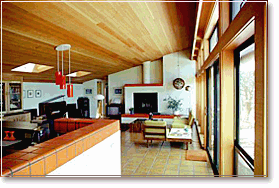Local Knowledge About Passive Solar Space Heating

Although passive solar heating is best incorporated into a house during the initial design, the concepts of passive solar heating can also be used when remodeling or adding to your home. Window design, and glazing choices in particular, are critical factors for determining the effectiveness of passive solar heating in a home. Large south-facing windows are generally used, as these have the most exposure to the sun allowing significant solar energy into the house and also providing daylighting. Properly sized overhangs can prevent overheating in the summer. ast- and west-facing windows generally cause excessive heat gains in the summer and heat losses in the winter, and are usually sized small. Although
overhangs are impractical for east- and west-facing windows, vertical shading can be used, or trees and shrubs can be strategically located to shade the windows. Thermal mass—such as tiles, masonry, or even water-filled walls—provides a means of storing the solar energy that enters through the windows. Built into the floors and walls near the south-facing windows, thermal mass will absorb solar energy during the day and keep the house from overheating. At night, the thermal mass will release the heat, keeping the house warm.
 Although passive solar heating is best incorporated into a house during the initial design, the concepts of passive solar heating can also be used when remodeling or adding to your home. Window design, and glazing choices in particular, are critical factors for determining the effectiveness of passive solar heating in a home. Large south-facing windows are generally used, as these have the most exposure to the sun allowing significant solar energy into the house and also providing daylighting. Properly sized overhangs can prevent overheating in the summer. ast- and west-facing windows generally cause excessive heat gains in the summer and heat losses in the winter, and are usually sized small. Although
overhangs are impractical for east- and west-facing windows, vertical shading can be used, or trees and shrubs can be strategically located to shade the windows. Thermal mass—such as tiles, masonry, or even water-filled walls—provides a means of storing the solar energy that enters through the windows. Built into the floors and walls near the south-facing windows, thermal mass will absorb solar energy during the day and keep the house from overheating. At night, the thermal mass will release the heat, keeping the house warm.
Although passive solar heating is best incorporated into a house during the initial design, the concepts of passive solar heating can also be used when remodeling or adding to your home. Window design, and glazing choices in particular, are critical factors for determining the effectiveness of passive solar heating in a home. Large south-facing windows are generally used, as these have the most exposure to the sun allowing significant solar energy into the house and also providing daylighting. Properly sized overhangs can prevent overheating in the summer. ast- and west-facing windows generally cause excessive heat gains in the summer and heat losses in the winter, and are usually sized small. Although
overhangs are impractical for east- and west-facing windows, vertical shading can be used, or trees and shrubs can be strategically located to shade the windows. Thermal mass—such as tiles, masonry, or even water-filled walls—provides a means of storing the solar energy that enters through the windows. Built into the floors and walls near the south-facing windows, thermal mass will absorb solar energy during the day and keep the house from overheating. At night, the thermal mass will release the heat, keeping the house warm.